 |
TOTAL LUNAR ECLIPSE OF 1975
Totality: 1975 May 24/25 Total Lunar Eclipse. Scan of Ektachrome 35-mm slide. Data unkown but probably from Gainesville, Florida with a Canon 35 mm SLR and unknown optics. Moon entered Penumbra abt. 10:59 p.m. EDT. Partial Eclipse began abt. 1:03 a.m. EDT. Totality from abt. 1:03 to 2:32 a.m. EDT with Max. at 1:48 a.m. EDT at altitude 39 deg. Partial Eclipse Ended abt. 3:36 a.m. and left Penumbra abt. 4:38 a.m. EDT. Slide slightly trimmed from original.
|
|
 |
TOTAL LUNAR ECLIPSE OF 2004
Totality: 2004 October Total Lunar Eclipse. Sunlight, streaming through Earth's atmosphere, is bent into the Earth's shadow filling the shadow with sunlight. Thus, the shadow may not be dark but can also be colored reddish since bluer colors are filtered out by the Earth's atmosphere. Darkness and the hue depend on conditions in the Earth's atmosphere at the time of the eclipse. Dust, moisture, temperature, etc. play a role. Some lunar eclipses are very dark, others bright. Colors can range from a dull copper color to a deep red and may vary across the lunar disk. Distance of the Moon from the center of the Earth's shadow also plays a role. Darkness and color can also vary across the lunar disk during the eclipse. Location: Gainesville. Florida. Photo Taken: 2004 October 27.
|
|
|
|
 |
TOTAL LUNAR ECLIPSE OF 2004 COMPOSITE
Lunar Eclipse Composite. Images from the 2004 October Total Lunar Eclipse.
Location: Gainesville. Florida.
Photo Taken: 2004 October 27
|
|
 |
TOTAL LUNAR ECLIPSE OF 2008
The Total lunar Eclipse of 2008 February 20/21. Totality lasted from 10:01 to 10:51 p.m. EST. Left: Partial Eclipse 09:20 p.m. EST, 1/400s;Center: Inside Totality 10:35 p.m. EST, 10s; Right: Reentering Penumbra 10:55 p.m. EST, 10s. Location: Gainesville, FL • 2008 Feb. 20/21. Photo Details: Tele Vue 76, f/6.3 APO Refractor + 20 mm Plossl + Canon Powershot A710 (Afocal Method), Foc. L. 5.8mm, ISO 200, f/2.8
|
|
 |
ECLIPSED SOLSTICE MOON IN STAR FIELD
The Solstice Lunar Eclipse of 2010 December 21. This eclipse coincided with the December solstice. The totally eclipsed Moon appears against background stars at 03:19 a.m. EST. (Photograph is not a composite of the eclipsed Moon and the star field but a single picture.) Click for larger version (necessary to see stars). Also see larger annotated version with some stars identified with their SAO Numbers (magnitudes in parentheses with decimal points omitted to avoid confusion with stars – some near magnitude 11). Location: Gainesville, Florida. Photo Details: December 21, 2010, 08:19:21 UT, Tele Vue 76 mm APO Refractor, Focal Length 480 mm, Canon EOS 5D Mark II, Exp. 1.0 sec at f/6.3, ISO 1600, White Balance Daylight. Taken 2m24s after greatest eclipse.
|
|
 |
HUNTER'S FULL MOON PENUMBRAL ECLIPSE
The Lunar Penumbral Eclipse of 2013 October 18. Did a lunar eclipse really occur Friday evening, 2013 October 18? Yes, it did—a penumbral lunar eclipse of the Hunter’s Full Moon! Skies were surprisingly clear at sunset and astute observers should have detected a subtle shading on the lower right side of the rising Moon. The public, however, probably would not have noticed anything different. Lunar penumbral eclipses are not exactly overwhelming! Still, look at the attached composite photo and one can easily see the eclipse. The shading on the lower right part of the Moon is obvious in the left image. The right image is essentially a normal full moon taken just before the Moon completely left the Earth’s penumbra. Left Image: 7:50 p.m. EDT taken at time of greatest eclipse (Moon's altitude 12 deg., penumbral mag. 79%) Right Image: 9:40 p.m. EDT taken 10 min. before Moon left Earth’s penumbral shadow. (Moon's altitude 38 deg.) Location: S.W Gainesville Environs, Florida. Photo Details: Canon DSLR EOS 5D Mark II, Lens Canon 100-400 mm, f/4.5-5.6, Ultrasonic IS with UV Filter at 400 mm, Exp. (left) 1/500 sec at f/11, ISO equiv. 1600; (right) 1/500 sec at f/8, ISO equiv. 200. Processed in Corel PaintShop Pro and cropped from original.
|
|
 |
A TAX DAY TOTAL LUNAR ECLIPSE WITH SPICA (FIRST TETRAD ECLIPSE)
Total Lunar Eclipse of 2014 April 15. This is the first total lunar eclipse of the 2014/15 lunar tetrad. (A tetrad is four successive total lunar eclipses.) The remaining three eclipses of this tetrad occur 2014 October, 8, 2015 April 4 and 2015 September 27/28. The bright star Spica (Alpha Virginis) appears about 1.5 degrees from the eclipsed Moon. Clouds filled the sky during the night but the sky cleared sufficiently in early morning hours to reveal the eclipsed moon. This eclipse not only occurred on "tax day" in the USA but also coincided with the beginning of the Jewish festival of Passover, which began on the evening of April 14. Location: Gainesville, Florida. Photo Details: April 15, 2014, 08:17 UT, Tele Vue 76 mm APO Refractor, Focal Length 480 mm, Canon EOS 5D Mark II, Exp. 8.0 sec at f/6.3, ISO 800. Image trimmed from original.
|
|

 |
TOTAL LUNAR ECLIPSE WITH URANUS (SECOND TETRAD ECLIPSE)
Total Lunar Eclipse of 2014 October 8. This is the second total lunar eclipse of the 2014/15 lunar tetrad. (A tetrad is four successive total lunar eclipses.) The first occurred six months earlier on April 15. The remaining two eclipses of this tetrad occur next year on April 4 and September 27/28. This was a moonset eclipse for the eastern USA with the eclipsed Moon setting in the west as the Sun rose. This eclipse nearly coincided with the beginning of the Jewish holiday of Sukkoth, which begins at sunset this day.
The first picture was taken about one minute after the total phase of the eclipse began (6:25 a.m. EDT). The moon is darker on the upper left because this part of the Moon is more deeply immersed in the Earth's shadow.
The faint planet Uranus (magnitude +5.7) appears to the upper left about one degrees from the eclipsed Moon.
The second picture was taken about 14 minutes into totality as the Moon began to disappear behind trees as the dawn sky brightened. Clouds again filled the sky during most of the night as during the previous eclipse but the sky cleared as the eclipse progressed. Location: Gainesville, Florida. Photo Details: April 15, 2014, 08:17 UT, Tele Vue 76 mm APO Refractor, Focal Length 480 mm, Canon EOS 5D Mark II, Exp. 8.0 sec at f/6.3, ISO 800 and 10 sec at f/6.3, ISO 1600. Images trimmed from originals.
|
|
 |
A TOTAL LUNAR ECLIPSE (THIRD TETRAD ECLIPSE)
Total Lunar Eclipse of 2015 April 4. This is the third total lunar eclipse of the 2014/15 lunar tetrad. (A tetrad is four successive total lunar eclipses.) The first two occurred 2014 April 15 and 2014 October 8. (See above images.) Unfortunately only the beginning partial phases of this total eclipse could be viewed from the eastern USA as the Moon set in the West. However, a lunar eclipse can be a teaching moment.
For example, many people seeing the partially eclipsed Moon might have remarked, "Looks like a quarter or possibly gibbous Moon." In fact, I wonder how many early morning joggers glanced at the partially eclipsed Moon and thought it just another "half moon." Not so! Look at this composite image of this partially eclipsed Moon taken about 25 minutes after the partial phases began at 6:18 a.m. EDT (with a 400-mm telephoto).
Next, compare this image with that of a 9-day-old Moon (73 percent illuminated) photographed at the 2010 May Kanapaha Moonlight Walk in Gainesville with a telescope. The two images have roughly similar "phases." Of course detail is better on the Gibbous Moon due to the presence of shadows (and better optics). This happens because an eclipsed Moon is actually a Full Moon so shadows are lacking and detail is lost. Yet this is not the most important difference.
Compare the shape of the terminator (day-night line) on the Gibbous Moon with the edge of the Earth's shadow on the partially eclipsed Moon. Very different. The partial phases of lunar eclipses do not mimic the appearance of the Moon in its usual monthly lunar cycle.
This is a lesson from antiquity. The circular shape of the shadow edge that one observes on an eclipsed Moon was one of the earliest indications that the Earth was round since a sphere is the only solid always producing a round shadow! A teaching moment. Photo Details: Canon DSLR EOS 5D Mark II, Lens Canon 100-400 mm, f/4.5-5.6, Ultrasonic IS at 400 mm, Exp. 0.3 sec at f/5.6, ISO 1600. (Image trimmed from original.)
|
|
 |
A TOTAL LUNAR ECLIPSE (FOURTH TETRAD ECLIPSE)
Total Lunar Eclipse of 2015 September 27/28. This is the forth and last total lunar eclipse of the 2014/15 lunar tetrad. (A tetrad is four successive total lunar eclipses.) The first thee occurred 2014 April 15, 2014 October 8 and 2015 April 4 (See above images.) Although the entire eclipse should have been visible from my area, weather did not cooperate.
If anyone observed from the Gainesville, Florida area, most probably saw nothing. In fact, heavy overcast skies here made it impossible to find where the Moon was on the sky.
Reports coming in from locations with clear skies state the eclipse was surprisingly very dark. It was certainly dark in Gainesville due to the heavy cloud cover!
Totality passed and nothing was seen due to the dark overcast above.
However, shortly before midnight clouds thinned enough over my backyard to show the partially eclipsed moon near the end of eclipse faintly shining from behind passing clouds.
A few drops of rain were actually falling when I snapped the attached photo and a few others before the Moon again disappeared behind heavy clouds.
This eclipse photo would normally be unremarkable except that the photo shows that this was probably the only view most of us had of the eclipse -- a brief, hazy peek after totality ended.
As the eclipse ended near 1:22 a.m. EDT, the Full Moon shone brightly through a cloud hole but only again for a brief time. Then it began to rain!
The attached photo, softened by clouds (taken 2015 Sept. 27, 11:59 p.m. EDT or 2015 Sept. 28, 03:59 UT) verifies what we saw as the Moon was coming out of Earth's umbral shadow before clouds again hid the Moon. Photo Details for Eclipsed Moon: Canon DSLR EOS 5D Mark II, Lens Canon 100-400 mm, f/4.5-5.6, Ultrasonic IS at 400 mm, Exp. 1/180 sec at f/9.5. (Image trimmed from original.)
|
|

Photo 1

Photo 2

Photo 3
|
SNOW MOON PENUMBRAL LUNAR ECLIPSE
Deep Penumbral Lunar Eclipse of 2017 February 10. February's Full "Snow Moon" produced a very deep penumbral lunar eclipse (mag. 0.989). This was almost an ideal penumbral eclipse with the Moon almost exactly fitting within the Earth's penumbral shadow.
In Gainesville, Florida, the Moon already rose in eclipse since the eclipse began about 5:32 p.m. EST with moonrise about 6:01 p.m EST. (sunrise 6:15 p.m. EST). Shading was already very obvious as the Moon rose above tree lines at 6:50 p.m. EST (Photos 1 and 2), about 60% into the eclipse. The shading was more obvious with the camera with Maria Frigoris, Imbrium and Serenitatis unnaturally dark for a full moon!
At maximum eclipse (Photo 3), at 7:44 p.m. EST or 00:44 UT on February 11, shading was exceptional on the lunar edge facing the umbral shadow toward the northeast.
Location: Gainesville, Florida. 2017 February 10.
Photo Details: Canon DSLR EOS 5D Mark II, Lens Canon 100-400 mm, f/4.5-5.6, Ultrasonic IS at 390 mm, tripod mount. Exposures at ISO 400.
Photo 1: 6:45 p.m. EST or 21:45 UT. Exp. 1/6 sec at f/5.6.
Photo 2: 6:51 p.m. EST or 21:51 UT (40% toward max. eclipse). Exp. 1/1500 sec at f/5.6.
Photo 3: 7:47 p.m. EST or 00:47 UT (3 min. after max. eclipse). Exp. 1/2000s at f/6.7.
(Both images trimmed from original.)
Don't forget to click images for larger versions.
|
|
 Eclipse Composite
Eclipse Composite

Lunar Eclipse Setting
(Click Each Image to Enlarge)
|
TOTAL LUNAR ECLIPSE OF 2018 JANUARY SETTING: BEFORE TOTALITY
Total Lunar Eclipse of 2018 January 31. Many news media reported the 2018 January 31 total lunar eclipse would be difficult or impossible to view from the Eastern USA. Why? The Moon would be too low and washed out by morning twilight to see much of anything. However, clear North Florida skies gave a splendid view of the eclipsed Moon although the Moon set before being completely immersed in Earth's umbral shadow. (Temperature near ground level about 27 deg F!)
The Moon setting in eclipse was spectacular. Picture shows composite of nine images taken during stages of the eclipse:
Photo Times: 5:54, 6:15, 6:36, 6:40, 6:50, 7:00, 7:04, 7:07, 7:09 a.m. EST (add 5h for UT).
Penumbral Eclipse Began: 5:49 a.m. EST
Moon Entered Umbra: 6:48 a.m. EST
Totality Started: 7:51 a.m. EST.Moonset and Sunrise: 7:20 a.m. EST so Moon set before totality began.
Although orange or reddish colors common during lunar eclipses, most of color here due to scattering of bluer colors by Earth's atmosphere, typical for rising or setting sun or moon.
Location: Gainesville, Florida suburbs. Tripod and camera set up about 5:00 a.m. EST, about a half mile east of SW 75th St. on the north side of SW 85th Ave, about 100 ft. off the road on a north dirt entryway to a cleared field. Here, one could see to about 1-1/2 degrees above the western horizon where the Moon would set, a requirement since the eclipse would occur with the Moon very low.
Details: Camera Canon DSLR EOS 5D II. Canon EF 100-400 mm, f/4.5-5.6 lens at 400mm .ISO 400. Various exposures. Some post processing. In this composite, line of setting only approximate, time intervals not uniform, and moon positions adjusted for equal spacings.
Second photo taken at 7:06 a.m. EST (12:06 UT) shows Moon partly within Earth's umbral shadow, 14 minutes before moonset and sunrise, with Moon altitude only two degrees. Moon finally set behind trees when only 1-1/2 degrees high. Exp. 1/30s, f/8, ISO 400. Image trimmed.
|
|
 Lunar Eclipse in Star Field
Lunar Eclipse in Star Field
(Click Image to Enlarge)
|
A GREAT AMERICAN TOTAL LUNAR ECLIPSE
Total Lunar Eclipse of 2019 January 20/21. Clear skies greeted Florida observers with the Moon high in the sky for the entire eclipse. The Moon entered into partial eclipse about 10:34 p.m. EST, totality at 11:41 p.m. EST, greatest eclipse at 12:21 a.m. EST,, totality ended 12:43 a.m. EST after 62 minutes of totality. Partial eclipsed ended 1:51 a.m. EST. Photo shows totality eclipsed Moon (about 3 min. before greatest eclipse) in Cancer star field, and is a composite of two separate exposures.
Location: Gainesville, Florida.
Photo Details: Tele Vue 76 mm APO Refractor, Focal Length 480 mm with Canon DSLR EOS 5D Mark II.
Star Field: 2019 Jan. 21, 12:13:48 a.m. EST. Exposure f/6.3, 15 sec (ISO 1600).
Moon: 2019 Jan 21, 12:17:42 a.m. EST. Exposure f/6.3, 1.5 sec. (ISO 1600).
|
|
 Eclipse Composite
Eclipse Composite

Lunar Eclipse Trails
(Click Each Image to Enlarge)
|
TOTAL LUNAR ECLIPSE OF 2021 MAY SETTING: BEFORE TOTALITY
Total Lunar Eclipse of 2021 May 26. Again Florida had another "total" lunar eclipse but the Moon unfortunately set before totality like the 2018 November eclipse. Still, once more clear North Florida skies gave a splendid view of the eclipsed Moon though the Moon set 35 minutes before totality began.
Picture #1: Twenty-eight image composite. Exposures 2m 27s apart beginning 4:47:26, ending 5:53:35 a.m. EDT
Picture #2: Shows lunar eclipse trail with images spaced 21 seconds apart.
Moon Entered Penumbra: 4:46 a.m. EDT (Add 4h for UT)
Moon Entered Umbra: 5:44 a.m. EDT
Moonset/Sunrise: abt. 6:35 a.m. EDT (72% within umbra)
Max. Eclipse: 7:16 a.m. EDT.
Orange/reddish colors common during lunar eclipses, but colors here mostly due to scattering of bluer colors by Earth's atmosphere as Moon set.
Location: S.W. Gainesville, Florida Suburbs.
Photo Info:
Canon DSLR EOS 5D II, Lens EF 28-135, f/3.5-5.6 IS USM @ 70 mm.
Exposures 1/125 sec at f/8; ISO Equiv. 400. Fixed Tripod Mount.
For spectacular animated view of pictures #1 and #2, see GIF Movie:

Click Above to View Animated GIF Movie of Pictures #1 and #2
(or See MP4 Movie Here)
|
|
 Partial Eclipse Through Clouds
Partial Eclipse Through Clouds
(Click Image to Enlarge)
Penumbral Eclipse 1:02 a.m.
Partial Eclipse 2:19 a.m.
Maximum Eclipse 4:03 a.m.
Partial Over 5:47 a.m.
Sunrise 6:58 a.m.
Penumbral Over 7:04 a.m.
Moonset 7:08 a.m. EST
|
AN ALMOST TOTAL LUNAR ECLIPSE of 2021 NOVEMBER 19.
Cloudy skies greeted North Florida observers for the early Friday morning 97.4% partial lunar eclipse, longest in centuries.
Almost. For a few short moments during early stages of the eclipse one could glimpse the Moon through occasional, hazy holes in the clouds. Final views were only a few seconds long as a thin shaped Moon disappeared from behind a heavy overcast as maximum eclipse approached.
Still, earlier when the Moon was only partially immersed in Earth's shadow, the hazy Moon briefly revealed itself surrounded by a beautiful luminous halo of colored clouds -- a pretty sight.
Though far from maximum eclipse, I snapped my camera' s shutter repeatedly hoping to record just a bit of the eclipse with its luminous ring of color. See picture. (A double exposure for both colored clouds and partially eclipsed Moon.) Times not recorded due to camera malfunction.
Location: Gainesville, Florida.
Details: Canon DSLR EOS 5D II, Lens EF 28-135, f/3.5-5.6 IS USM @ 135 mm.
Exposures: f/6.3, ISO 1600. 1/8 sec (Clouds), 1/250 sec (Moon).
|
|
(Click Images to Enlarge)
 Early Evening Rainbow
Early Evening Rainbow

Eclipse Composite
 Eclipsed Moon in Star Field
Eclipsed Moon in Star Field
 Eclipsed Moon in Star Field (Labeled)
Eclipsed Moon in Star Field (Labeled)
|
THE GREAT USA TOTAL LUNAR ECLIPSE OF 2022 MAY 15/16. This was an extraordinary total lunar eclipse due to its long duration of totality (abt. 85 min) and convenient observing time for Florida with totality from 11:29 p.m (May 15) to 12:54 a.m EDT (May 16).
But rain, lightning and thunder in early evening threatened viewing eclipse and delayed setting up. A rainbow appeared about 7:45 p.m. EDT (sunset 8:15 p.m. EDT), just before skies cleared. Photo taken 22 June 15, 7:42 p.m. EDT with Nikon Coolpix S9900. Exposure: 1/1000s @ f/3.7, ISO 125.
Setup during penumbral eclipse (9:32-10:28 p.m. EDT) and finished setup by 10:00 p.m when began taking pictures. However, did not realize until later that weight of camera was causing telescope to go out of focus causing loss of many images. Dimming Moon as totality approached made focusing near impossible. Needed to take trial images (very time consuming) to constantly adjust focus.
Still managed to salvage enough images to make composite of eclipse. In addition, a few photos during totality showed star field around Moon. (Also see labeled version showing some star identification numbers and magnitudes.)
AND SEE:
- MP4 Video showing Eclipse Preview (also on YouTube):
"A Great Florida Total Lunar Eclipse"
THEN SEE:
- MP4 Video for a Dairy Account of these photos (also on YouTube):
"A Great USA Total Lunar Eclipse: My Night Under the Dark of the Moon - A Dairy")
Details:
Location: Gainesville, Florida.
Telescope: Tele Vue 76 (76 mm, f/6.3 APO Refractor) + iOptron iEQ30 Mount
Camera: Canon DSLR EOS 5D II with
Exposures Times (EDT or 4h after UT):
Composite:
- Moon 59% into Penumbra@ 10:05 a.m. (1/3000, ISO 1250)
- Beginning Partial Eclipse @ 10:33 a.m. (1/750, ISO 400)
- Partial Eclipse 26m Before Totality @ 11:03 a.m. (1/500, ISO 800)
- Partial Eclipse Ending, 8m Before Totality @ 11:21 a.m. (1/10, ISO 1250)
- Total Eclipse 55m in @ 12:28 a.m. (10 sec, ISO 1600)
- Moon at End of Totality @ 12:55 a.m. (0.5 sec, ISO 1600)
- Partial Eclipse 22m after Totality @ 1:16 a.m. (1/125, ISO 1000)
- Partial 41m after Totality @1:35 a.m. (1/250, ISO 400)
- Penumbral 11m after Partial @2:06 a.m. (1/1000, ISO 400)
- Moon 7m After Eclipse @ 2:58 a.m. (1/1000, ISO 200)
Moon in Star Field: 2022 May 16, 12:28 a.m. EDT (10s, ISO 1600)
|
|
 Totally Eclipsed Moon in Star Field with Pleiades
Totally Eclipsed Moon in Star Field with Pleiades
Uranus also appeared
2° above Moon.
Can you find it?
Probably not.
But click image to enlarge,
and put cursor
over image
for annotation.
|
ELECTION DAY BEAVER MOON TOTAL LUNAR ECLIPSE 2022 NOVEMBER 8.
The totally eclipsed "Beaver Moon" moon appears here 15 degrees high in the western sky (azimuth 281°) 20 minutes into an 85 minute long period of totality in a star field with Pleiades Star Cluster (near top). Composite of two exposures (Moon and star field). Totality ended 13 minutes before moonset during civil twilight.
Eclipse occurred on morning of 2022 USA Election Day, a first time occurrence not to be repeated until 2394 and fortunately two days before Hurricane Nicole crossed Florida.
This was a very beautiful "blood moon" eclipse with moderate brightness (Danjon Value L2-L3) and a bright limb with a noticeable gradient across the lunar disk. Also, the Pleiades Star Cluster was clearly visible about 16 degrees above the Moon.
Finally, the planet Uranus was about two degrees above the Moon at magnitude +5.6. (An occultation occurred for much of eastern Asia.) Some news media touted the appearance of Uranus but typically got it wrong! For example, the Washington Post (Marcia Dunn, AP, Nov. 6, 2022) wrote:
"As an extra treat, Uranus will be visible just a finger’s width above the moon, resembling a bright star."
At magnitude +5.6, Uranus would have hardly been a bright star. In fact, Uranus could probably be seen only in binoculars or a telescope since naked eye visibility under very dark skies is about mag. +6. (Uranus was not discovered until after the invention of the telescope.)
Details:
Location: Hammock Ridge Development, Gainesville, Florida
Time: approx. 5:36 a.m. EST (10:36 UT)
Camera: Canon DSLR EOS 5D II, fixed mount (unguided so some star trailing)
Lens: Canon 50mm, f/1.8 at f/2.5
Exposure: f/2.5 (ISO 1600)
Composite of 10 sec and Moon 1/6 sec exposures
(Processed in Corel PaintShop Pro and Microsoft PowerPoint.)
|
|

Fig. 1 Cloudy Eastern Sky as Harvest Moon Rises Before Eclipse Began. (Orange Streak at Lower Left from Street Light.)
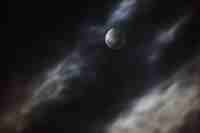
Fig. 2 Moving Clouds Hide Moon During Ending Penumbral Eclipse.
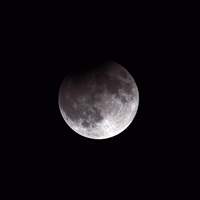
Fig. 3 Partially Eclipsed Moon at Maximum Eclipse. Umbral Shadow is Clearly Visible at Upper Left.
(Eclipse Magnitude abt. 8%).
|
PARTIAL LUNAR ECLIPSE OF THE HARVEST, PERIGEAN MOON 2024 SEPTEMBER 17.
In case you missed it, an itty-bitty partial lunar eclipse occurred with only about about 8% of the lunar disk within Earth's umbral shadow during the Harvest Full Moon of 2024. This was also a perigean Moon (called by some a "supermoon."). In Gainesville, North Florida, clouds interfered with the beginning and end of the eclipse. See Figure 1 and Figure 2.
However, clear skies in-between clearly showed the edge of the Moon immersed within Earth's umbra. See Figure 3 taken within a minute of Maximum Eclipse when Moon about eight percent inside umbra.
Fortunately, sky was clear during umbral phases though hazy with poor transparency, allowing Moon to still shine brightly. (Temperature about 76°F or 24°C with high humidity, abt. 75-80%.)
Click images to see larger versions in new windows.
Photo Details:
Location: S.W. Gainesville, Florida.
Date: 2024 September 17/18
Camera: Canon DSLR EOS 5D II, fixed mount.
Fig. 1. Time: 8:15 p.m. EDT Sept. 17 (00:15 UT, Sept. 18).
Lens: Canon EF 28-135 mm (f/3.5-5.6 IS USM) @ 135 mm.
Exposure: 2 sec @ f/8, ISO 1600.
Fig. 2. Time: 11:28 p.m. EDT Sept. 17 (03:28 UT, Sept. 18).
Lens: Canon EF 100-400 mm (f/4-5.6 IS USM) @ 400 mm.
Exposure: 1 sec @ f/8, ISO 1600.
Fig. 3. Time: 10:45 p.m. EDT Sept. 17 (01:45 UT, Sept. 18).
Lens: Canon EF 100-400 mm (f/4-5.6 IS USM) @ 400 mm.
Exposure: 1/1000 sec @ f/8, ISO 400.
Photo Taken at Maximum Eclipse.
Image Trimmed from Original.
(Processed in Corel PaintShop Pro and Microsoft PowerPoint.)
|
|
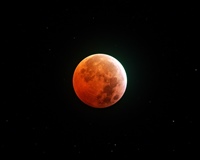
Fig. 1 Totally Eclipsed Moon in star field in Leo near Leo/Virgo boundary (abt. 0.1° to upper left of lunar limb). 89 Leo (mag. +5.8) sits about one moon diameter down to right of Moon, A2777 (mag. +7.2) to upper right.
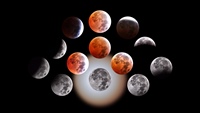
Fig. 2 Eclipse Composite. Corona appeared around Moon during ending penumbral phase.
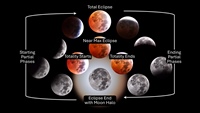
Fig. 3 Eclipse Composite Labeled.
|
PI DAY GREAT AMERICAN TOTAL LUNAR ECLIPSE 2025 MARCH 13/14.
Viewable over the Americas (North and South), North Florida skies remained mostly clear for this beautiful eclipse. Although the entire eclipse was observable, the eclipse did not begin until near midnight (EDT) March 13 with maximum eclipse about 3:00 a.m. EDT March 14. Hence, many did not stay up to witness the eclipse. Note that eclipse occurred on "Pi Day" (March 14 or 3/14).
Eclipse Times (EDT or UT-5h)
| Enters Penumbra | 11:57 pm |
Partial Eclipse Begins | 1:09 am |
| Total Eclipse Begins | 2:26 am |
Mid-Eclipse | 2:59 am |
| Total Eclipse Ends | 3:32 am |
Partial Eclipse Ends | 4:48 am |
| Leaves Penumbra | 6:01 am
| |
Figure 1: Totally eclipse Moon in star field (just after mid-eclipse).
Figure 2: Composite showing various stages of the eclipse.
Figure 3: Composite labeled.
(Click images to enlarge)
Notice the bottom center image of >Figures 2 or 3 shows the end of the eclipse with a bright colored glow around the moon or a "moon corona" caused by middle level clouds made of water droplets causing the diffraction of light. This was remarkable to see for an eclipse.
In fact, during the end of the eclipse, these clouds made the once clear sky hazy hiding even many bright stars. To photograph this phenomenon, two exposures were used, one for the now bright, nearly uneclipsed Moon and one for the fainter corona.
Photo Details:
Location: S.W. Suburbs of Gainesville, Florida USA
Date: 2025 March 13/14
Telescope: Tele Vue-76, 76mm, f/6.3 APO Refractor
Camera: Canon DSLR EOS 5D II on SkyAdventurer GTi
Processing: Corel PaintShop Pro and Microsoft PowerPoint.
(Images Trimmed from Original).
Figure 1. Times: 3:03 am EDT & 3:06 am EDT
Exposure: 30s, f/ 6.3, ISO 1600 & 07.s, f/6.3, ISO 1600
(Two exposures: one for Moon, one for star field)
Figures 2/3. Times: 1:13 a.m. to 5:17 a.m.
Exposures: Various (mid-eclipse 2 sec at ISO 1600)
Moon with Corona: 1/750 sec & 0.3 sec at ISO 200
(Two exposures: Moon & for corona)
|
|
|